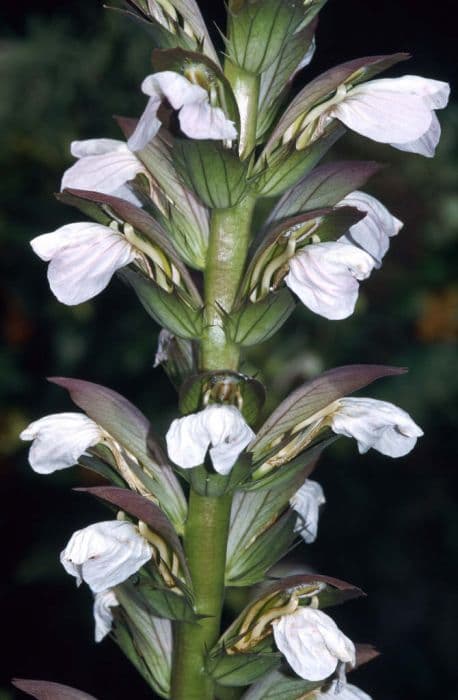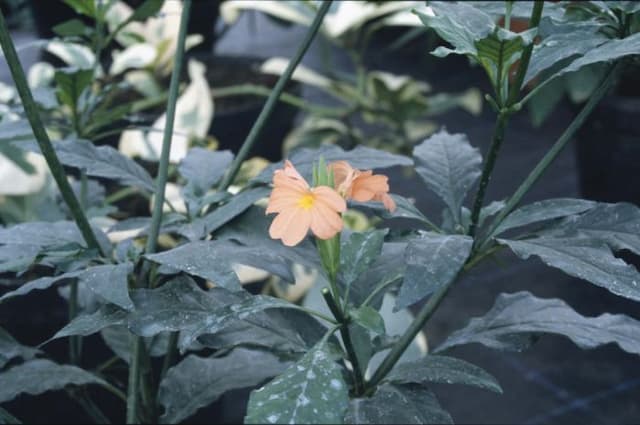Persian Shield Strobilanthes dyeriana

ABOUT
The Persian Shield, known for its striking foliage, boasts an array of iridescent leaves that capture the essence of a tropical fantasy. Each leaf is a work of art, shaped like a lance with a pointed tip and slightly serrated edge, giving the foliage a dynamic texture. The leaves radiate shades of purple, from deep violet to lavender, interlaced with dark green veins, adding to its mystical allure. Depending on the light, the leaves can also shimmer with silver, adding a metallic luster that further accentuates its beauty. This vibrant color palette lends the Persian Shield an ornamental charm that can brighten any garden or indoor space. The plant typically produces small, tubular flowers, but it is the mesmerizing leaves that are the undeniable stars, drawing the eye and inviting admiration. Overall, the Persian Shield has a lush and exotic appearance that can provide a visual feast to any plant enthusiast or admirer of natural beauty.
About this plant
 Names
NamesFamily
Acanthaceae
Synonyms
Persian Shield, Royal Purple Plant
Common names
Strobilanthes dyerianus.
 Toxicity
ToxicityTo humans
The Strobilanthes dyeriana, most commonly known as the Persian shield, is not considered toxic to humans. Therefore, accidental ingestion of the plant is not expected to cause poisoning or severe symptoms in humans.
To pets
The Persian shield is also not considered toxic to pets such as dogs and cats. If a pet ingests parts of this plant, it is not expected to experience significant symptoms of poisoning. However, it is always a good practice to monitor your pets for any adverse reactions when they ingest plant matter, as individual sensitivities can vary.
 Characteristics
CharacteristicsLife cycle
Perennials
Foliage type
Evergreen
Color of leaves
Mixed
Height
3 feet (0.91 meters)
Spread
3 feet (0.91 meters)
Plant type
Shrub
Hardiness zones
9
Native area
Myanmar
Benefits
 General Benefits
General Benefits- Ornamental Appeal: Strobilanthes dyeriana, commonly known as Persian Shield, has iridescent purple leaves that add striking color and texture to garden landscapes and indoor plant collections.
- Drought Tolerance: Once established, it can tolerate short periods of drought, making it suitable for gardeners with limited watering resources.
- Shade Tolerance: Persian Shield can thrive in partial shade, offering gardeners a vibrant option for low-light areas in their gardens or homes.
- Heat Resistance: It can withstand high temperatures, which makes it a good choice for gardens in warmer climates.
- Container Gardening: Persian Shield is well-suited for pots and containers, allowing it to be placed on patios, balconies, or as an indoor houseplant.
 Medical Properties
Medical PropertiesThis plant is not used for medical purposes.
 Air-purifying Qualities
Air-purifying QualitiesThis plant is not specifically known for air purifying qualities.
 Other Uses
Other Uses- As a natural dye: The leaves of the Persian Shield may be used to create a natural dye for fabrics, offering a range of colors from green to gray depending on the mordant used.
- Photography backdrop: With its vibrant purple foliage, the Persian Shield can serve as a stunning backdrop for photographers, especially when shooting images of insects and other small wildlife.
- Psychological well-being: The striking appearance of the Persian Shield can contribute to a sense of well-being by providing visual stimulation and improving the aesthetic of indoor spaces.
- Educational tool: The Persian Shield's unique coloration makes it an excellent subject for educational purposes, allowing teachers to discuss plant pigmentation and photosynthesis with students.
- Seasonal decoration: Its vibrant purple leaves make the Persian Shield a popular choice for adding a splash of color in autumnal and Halloween-themed displays.
- Artistic inspiration: Artists may use the Persian Shield as a muse or reference for paintings, drawings, and other forms of visual art due to its unique color and leaf structure.
- Event theming: The Persian Shield is often utilized as part of decor for events that require a touch of exotic or tropical themes, thanks to its distinctive appearance.
- Privacy screening: When planted densely in outdoor gardens, the Persian Shield can provide a natural and colorful screen for privacy purposes.
- Color contrast in gardening: The plant is often used to provide striking color contrast in floral arrangements and garden designs.
- Hobby gardening: The Persian Shield is popular among hobby gardeners who enjoy propagating unusual plants, as it can be propagated easily from cuttings.
Interesting Facts
 Feng Shui
Feng ShuiThe Persian Shield is not used in Feng Shui practice.
 Plant Symbolism
Plant Symbolism- Mystery: Often referred to as the Persian Shield, Strobilanthes dyeriana boasts iridescent purple leaves, symbolizing the allure and enigma of the unseen and the mystical.
- Royalty: The striking purple hue of the Persian Shield's foliage is traditionally associated with royalty and nobility, reflecting its regal and luxurious appearance.
- Intuition: The plant's vibrant coloration is believed to stimulate intuition and insight, resonating with the third eye chakra which is related to perception beyond ordinary sight.
- Chief Defence: In some cultures, the robust nature of the Persian Shield, which is hardy and resilient, represents protection and the ability to shield oneself from negative influences.
- Persistence: Given the Persian Shield's ability to thrive under various conditions, it symbolizes persistence and adaptability in the face of challenges.
 Water
WaterThe Persian Shield prefers to have consistently moist soil, so water it thoroughly when the top inch of soil begins to dry out. This might mean watering every few days during the active growing season, generally about 16 ounces per week, depending on the size of the plant and the environmental conditions. During winter, reduce the frequency to avoid waterlogging, which might be around 8 ounces every two weeks. It’s essential to ensure proper drainage to prevent root rot.
 Light
LightPersian Shield thrives in bright, indirect light but can also tolerate partial shade. It’s best situated in a spot that receives filtered sunlight for most of the day, avoiding the intense direct afternoon sun which could fade its vibrant leaf coloration. An east or north-facing window usually provides ideal lighting conditions for this plant.
 Temperature
TemperaturePersian Shield prefers temperatures between 60°F and 75°F and can survive in temperatures as low as 50°F and as high as 90°F. It is not frost-tolerant, so if grown outside it must be brought indoors or provided protection when the temperature drops below 50°F. The ideal environment would mimic its tropical origins, remaining warm and avoiding sudden temperature drops.
 Pruning
PruningPruning Persian Shield helps to maintain its bushy appearance and encourages fuller growth. Prune in the spring, just before the growing season begins, by cutting back leggy stems and any dead or yellowing leaves. Regular pinching of the tips can also promote bushier growth. This task is usually carried out every few months or as needed when the plant looks unkempt.
 Cleaning
CleaningAs needed
 Soil
SoilPersian Shield prefers a rich, well-draining soil mix with a pH ranging from slightly acidic to neutral (pH 5.5 to 7.5). A blend of peat, compost, perlite, and regular potting soil works well for ensuring proper drainage and fertility.
 Repotting
RepottingPersian Shield should typically be repotted every 2-3 years or when it becomes root-bound. Spring or early summer is the best time for repotting this plant.
 Humidity & Misting
Humidity & MistingPersian Shield thrives in high humidity conditions and will benefit from a humidity level of around 40-60%. It can tolerate lower humidity but prefers more tropical conditions.
 Suitable locations
Suitable locationsIndoor
Provide bright, indirect light and maintain high humidity.
Outdoor
Plant in dappled shade and shelter from strong winds.
Hardiness zone
9-11 USDA
 Life cycle
Life cycleStrobilanthes dyerianus, commonly known as Persian Shield, begins its life cycle as a seed that, when sown in warm, moist soil and provided with ample light, will germinate. Seedlings quickly establish themselves and begin to develop the plant's characteristic iridescent purple leaves with a silvery sheen. The vegetative stage sees the Persian Shield growing and branching, forming a bushy shrub that can reach heights of 18-36 inches. As it matures, if provided with proper care, including bright light and regular watering, the plant may produce small, tubular flowers, although blooming is infrequent in cooler climates. Persian Shield is a short-lived perennial or subshrub, often grown as an annual in temperate regions, and it may begin to decline after a few years, requiring propagation by cuttings to continue its lineage. Taking stem cuttings from this plant is an effective way to ensure continued growth, as they readily root and grow into new plants, thereby perpetuating the life cycle.
 Propogation
PropogationPropogation time
Spring-Summer
The most popular method of propagating the Persian Shield, scientifically known as Strobilanthes dyeriana, is through cuttings. The best time for propagation is during the warmer months of spring and summer when the plant's growth is most vigorous. To propagate, a gardener would take a cutting that is about 3 to 5 inches (approximately 7.6 to 12.7 centimeters) long, making sure it has several leaf nodes. These cuttings are then stripped of the lower leaves and the cut end may be dipped in rooting hormone before being planted in a mixture of peat and perlite or a well-draining potting mix. The cuttings should be kept moist and in a warm place with bright, indirect light. Roots typically begin to establish after a few weeks, at which point the cutting can gradually be acclimated to more direct light and less frequent watering.









